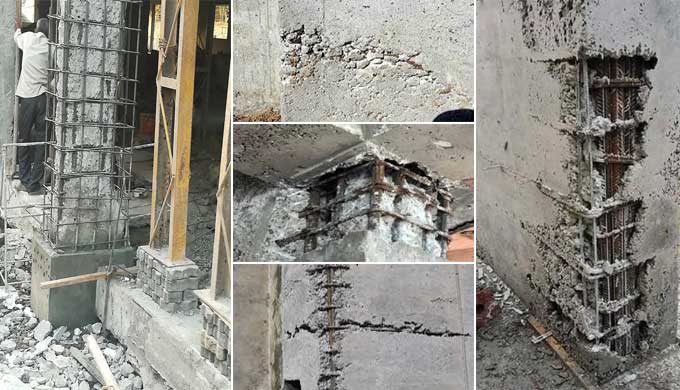
The Causes, Effects, and Prevention of Honeycombing in Concrete
Honeycombing is a concrete defect due to which cavities and hollow pockets form, resulting in coarse aggregates being prominently visible.
The concrete does not fill against the formwork, which causes this problem.
The use of super stiff concrete or not vibrating the concrete until it has cured can also cause honeycombing. The honeycomb effect makes concrete weaker as well as making the reinforcement more vulnerable.
Honeycombs can see with the naked eye after the shuttering of formwork is removed.
A technique like ultrasonic testing allows the detection of honeycombs that cannot be seen with the naked eye and are hidden inside the mass of concrete.
Causes of Honeycombing in Concrete
- Poor grading or mixing of the aggregates may cause insufficient fines in the mixture.
- An improperly workable concrete, such as stiff concrete that is difficult to place.
- Concrete that has not compacted properly.
- Pouring concrete from a height causes aggregates and mortar to separate causing honeycombing.
- Typical places: Concrete should be placed carefully on joints such as those between beams or between beams and columns. A layer of reinforcements lapping upon another makes the concrete hard to penetrate.
- A high proportion of large coarse aggregates in concrete: Fewer small particles can penetrate concrete that contains aggregates of larger sizes. As a result, honeycombing occurs.
- Concrete forms move before they are dried.
- The concrete was already set before it was placed.
- No waterproof or watertight formwork is used.
- Ratio of water to cement is incorrect.
- Fewer reinforcements.
Effects of Honeycombing in Concrete
- Structures are less strong and bear less weight.
- Structures that are less durable or last less long.
- The rebar has rusted and corroded.
- The aesthetics are poor.
- Ensures air and water can enter concrete.
Prevention of Honeycombing in Concrete
- It is recommended to use aggregates with a good grade.
- Ensure water-tight formwork.
- To prevent over compaction or low compaction, it is necessary to compile properly.
- Make use of concrete with a good workability and prepared in accordance with proper mixing proportions.
- You should use concrete that is cohesive. A cohesive concrete mix is one that can be molded into a ball.
- It is important to keep concrete falls to a minimum. The maximum height of the concrete fall should not exceed 1 meter.
- Maintain the proper ratio of water to cement.
- Concrete must be dried before formwork can move.
- The concrete should be properly filled against the formwork if proper spacing between reinforcements is provided.
Avoid Honeycombing in Concrete
Sometimes avoiding is better than curing; here are some key points that will help to avoid Honeycombing in concrete.
- It is essential to ensure that the concrete mix contains adequate cement mortar gel to fill voids between coarse aggregates.
- Depending on the concrete conditions, choose the right workability.
- Make sure that the concrete is properly and adequately compacted, and that the laying method minimizes segregation risks.
- The concrete section shape and its reinforcement must allow concrete to flow around the reinforcement so that the forms are completely filled.
- If you are going to put it in concrete, make sure the formwork for the foundation is rigid, the joints are watertight, and there are no penetrations through the formwork, for example, form ties that need to be properly sealed.
Conclusion
The reinforced concrete material has generally been considered durable for structural purposes. Furthermore, it requires very little maintenance and can sustain for many decades.
Concrete's versatility has made it the most popular structural material across the globe. Although concrete is a very strong material, several factors can cause defects or damage, such as severe exposure conditions, poor design, poor detailing, and poor construction techniques.
There are many different types of defects in concrete, but the honeycomb defect belongs to the most critical defects. Ensure concrete is properly prepared by following the steps above.


